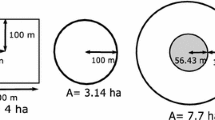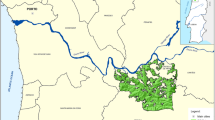Abstract
Abundant and continuous old forest tend to be fragmented into isolated and small patches because of human harvest activities. Dispersive and isolated old forest patches cannot provide abundant interior habitat to wildlife, which is a fatal threat for specific plant communities and wildlife species. In this paper, an Integer Programming model for forest planning is designed to maximize the economical benefit of the forest and to guarantee a minimum area of interior old forest for wildlife habitat, the so-called core area satisfying minimum mature age requirements. The minimum core area constraints, to some degree, can help mitigate the negative impact of harvest activities to divide forest habitat into many small patches. The model is implemented in a commercial Integer Programming solver and it is applied to several hypothetical landscapes. The results show the possibility of incorporating a core area requirement into a forest planning model, and the possibility to obtain solutions within a reasonable computational time. Instances with up to 1600 management units have been solved in seconds to an optimality gap of 1% (0.1% in some cases).
Similar content being viewed by others
References
Baskent, E., & Jordan, G. (1995). Characterizing spatial structure of forest landscapes. Canadian Journal of Forest Research, 25, 1830–1849.
Bettinger, P., & Boston, K. (2001). Development of spatially feasible forest plans: a comparison of two modeling approaches. Silva Fennica, 35(4), 425–435.
Bettinger, P., & Zhu, J. P. (2006). A new heuristic method for solving spatially constrained forest planning problems based on mitigation of infeasibilities radiating outward from a forced choice. Silva Fennica, 40(2), 315–333.
Bettinger, P., Boston, K., & Sessions, J. (1999). Intensifying a heuristic forest harvest scheduling search procedure with 2-opt decision choices. Canadian Journal of Forest Research, 29, 1784–1792.
Bettinger, P., Graetz, D., Boston, K., Sessions, J., & Chung, W. (2002). Eight heuristic planning techniques applied to three increasingly difficult wildlife planning problems. Silva Fennica, 36(2), 561–584.
Boston, K., & Bettinger, P. (2002). Combining tabu search and genetic algorithm heuristic techniques to solve spatial harvest scheduling problem. Forest Science, 48(1), 35–46.
Brumelle, S., Granot, D., Halme, M., & Vertinsky, H. (1998). A tabu search algorithm for finding good forest harvest schedules satisfying green-up constraints. European Journal of Operational Research, 106, 408–424.
Caro, F., Constantino, M., Martins, I., & Weintraub, A. (2003). A 2-opt tabu search procedure for the multiperiod forest harvesting problem with adjacency, greenup, old growth, and even flow constraints. Forest Science, 49(5), 738–751.
Constantino, M., Martins, I., & Borges, J. G. (2008). A new mixed integer programming model for harvest scheduling subject to maximum area restrictions. Operations Research, 56, 542–551.
Falcão, A. (1997). Dunas-a growth model for the national forest of leiria. In Proceedings of empirical and process-based models for forest tree and stand growth simulation, Oeiras, Portugal (pp. 20–26).
Falcão, A. O., & Borges, J. G. (2002). Combining random and systematic search heuristic procedures for solving spatially constrained forest management scheduling models. Forest Science, 48(3), 608–621.
Hoganson, H. M., Bixby, J., Bergmann, S., & Borges, J. G. (2004). Large-scale planning address interior space production three case studies from northern Minnesota. Silva Lusitana, 12(especial), 35–47.
Lockwood, C., & Moore, T. (1993). Harvest scheduling with spatial constraints: a simulated annealing approach. Canadian Journal of Forest Research, 23, 468–478.
McDill, M. E., & Amateis, R. L. (1992). Measuring forest site quality using the parameters of a dimensionally compatible height growth function. Forest Science, 38(2), 409–429.
McDill, M. E., Rebain, S. A., & Braze, J. (2002). Harvest scheduling with area-based adjacency constraints. Forest Science, 48(4), 631–642.
Murray, A. T. (1999). Spatial restrictions in harvest scheduling. Forest Science, 45(1), 45–52.
Murray, A. T., & Church, R. L. (1996). Analyzing cliques for imposing adjacency restrictions in forest models. Forest Science, 42(2), 166–175.
Öhman, K. (2000). Creating continuous areas of old forest in long-term forest planning. Canadian Journal of Forest Research, 30, 1817–1823.
Öhman, K., & Eriksson, L. O. (1998). The core area concept in forming contiguous areas for long-term forest planning. Canadian Journal of Forest Research, 28, 1032–1039.
Öhman, K., & Eriksson, L. O. (2002). Allowing for spatial consideration in long-term forest planning by linking linear programming with simulated annealing. Forest Ecology and Management, 161, 221–230.
Öhman, K., & Lämås, T. (2005). Reducing forest fragmentation in long-term forest planning by using the shape index. Forest Ecology and Management, 212, 346–357.
Rebain, S., & McDill, M. E. (2003). A mixed-integer formulation of the minimum patch size problem. Forest Science, 49(4), 608–618.
Tóth, S. F., & McDill, M. E. (2008). Promoting large, compact mature forest patches in harvest scheduling models. Environmental Modeling and Assessment, 13(1), 1–15.
Wei, Y., & Hoganson, H. M. (2005). Landscape impacts from valuing core area in national forest planning. Forest Ecology and Management, 218, 89–106.
Wei, Y., & Hoganson, H. M. (2006). Spatial information for scheduling core area production in forest planning. Canadian Journal of Forest Research, 36, 23–33.
Weintraub, A., & Murray, A. T. (2006). Review of combinatorial problems induce by spatial forest harvesting planning. Discrete Applied Mathematics, 154, 867–879.
Wolsey, L. A. (1998). Integer programming. New York: Wiley.
Xpress-MP (2007). www.dashoptimizatiom.com.
Author information
Authors and Affiliations
Corresponding author
Rights and permissions
About this article
Cite this article
Zhang, H., Constantino, M. & Falcão, A. Modeling forest core area with integer programming. Ann Oper Res 190, 41–55 (2011). https://doi.org/10.1007/s10479-009-0517-4
Published:
Issue Date:
DOI: https://doi.org/10.1007/s10479-009-0517-4




